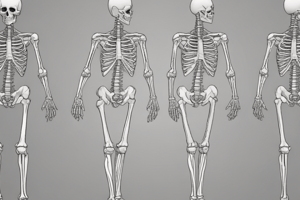Podcast
Questions and Answers
What is the key point for C2 in the Cervical Plexus examination?
What is the key point for C2 in the Cervical Plexus examination?
- Acromioclavicular joint
- Key muscle testing
- Middle of the supraclavicular fossa
- External occipital protuberance (correct)
Which muscle is tested in the Brachial Plexus examination for C7?
Which muscle is tested in the Brachial Plexus examination for C7?
- Flexor digitorum profundus
- Triceps (correct)
- Abductor digiti minimi
- Biceps
What is the method used in the Distraction test during a neurological examination?
What is the method used in the Distraction test during a neurological examination?
- Lifting the legs
- Tapping on the back
- Pressing on the abdomen
- Placing one hand under the chin and the other under the occiput (correct)
What type of end feel is considered normal during range of motion tests?
What type of end feel is considered normal during range of motion tests?
Which scale is commonly used for pain assessment in the provided text?
Which scale is commonly used for pain assessment in the provided text?
What aspect of a patient's facial expression should be observed during examination as per the text?
What aspect of a patient's facial expression should be observed during examination as per the text?
During palpation, what should be assessed in the soft tissues?
During palpation, what should be assessed in the soft tissues?
Which of the following is a movement that should be checked during the neurological examination as described in the text?
Which of the following is a movement that should be checked during the neurological examination as described in the text?
What is the purpose of neck traction in relieving pain?
What is the purpose of neck traction in relieving pain?
How is the Compression test conducted?
How is the Compression test conducted?
What is the purpose of the Valsalva maneuverer test?
What is the purpose of the Valsalva maneuverer test?
What does a positive response to the Valsalva maneuverer test indicate?
What does a positive response to the Valsalva maneuverer test indicate?
Study Notes
Cervical and Brachial Plexus Examination
- C2 in the Cervical Plexus examination key point involves assessing the function of the sternocleidomastoid muscle.
- C7 in the Brachial Plexus examination primarily tests the strength of the triceps muscle.
Neurological Examination Techniques
- The Distraction test is used to alleviate upper cervical spine pain by utilizing a gentle pulling force on the head.
- Normal end feel during range of motion tests is characterized as a soft or firm resistance without pain.
Pain Assessment and Observation
- The Numerical Rating Scale (NRS) is commonly used for pain assessment, allowing patients to rate their pain on a scale of 0 to 10.
- A patient's facial expression should be observed for signs of distress, discomfort, or pain during the examination.
Palpation and Movement Assessment
- During palpation, assessment of soft tissues includes checking for tenderness, tightness, and any abnormalities.
- Movements such as flexion, extension, and rotation should be checked during the neurological examination for functionality and pain response.
Therapeutic Techniques and Tests
- The purpose of neck traction is to relieve pain by reducing pressure on spinal nerves and promoting circulation.
- The Compression test involves applying pressure on the cervical spine to assess for nerve root compression symptoms.
- The Valsalva maneuver test serves to identify increased intrathecal pressure, which can indicate the presence of herniated discs or other issues.
- A positive response to the Valsalva maneuver test indicates that symptoms, such as pain or discomfort, are reproduced or increased, suggesting potential nerve root irritation.
Studying That Suits You
Use AI to generate personalized quizzes and flashcards to suit your learning preferences.
Description
Learn about orthopedic examination techniques including overpressure check for end feel and neurological examination focusing on the cervical and brachial plexus. Explore range of motion tests, active movements for flexion, extension, rotation, side flexion, combined movements, repetitive movements, and sustained positions.




